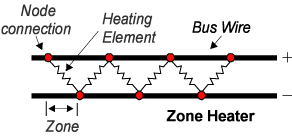
Every pipe or vessel is subject to heat loss when its temperature is greater than ambient temperature. Thermal insulation reduces the rate of heat loss but does not eliminate it. Trace heating maintains the temperature above freezing by balancing heat lost with heat supplied.
Even in buildings -
Where water storage is likely to be subject to temperatures below freezing, lagging and heating maybe required.
In areas that, under normal circumstances, have ambient temperatures well above freezing then lagging and trace heating will not be required. In these instances it is the responsibility of the occupier to ensure that the ambient temperature within the building is always kept above freezing.
This is particularly important if the property is left unattended for a long period of time in the winter and we would advise that the heating is left on a ‘frost' setting whilst unoccupied.
The Need: Freeze Protection to Fire Sprinkler Pipework
RC38 Fire Protection Association recommends the following:
Areas subject to freezing Many industrial premises have areas which could be subject to freezing temperatures, for example:
(d) the pump house (BS EN 12845, Clause 10.9.2, requires that diesel engines be maintained above 5°C for ease for ease of starting);
(e) areas normally heated but temporarily unheated during out-of-work hours, weekends or winter holidays;
1.3 Main frost protection methods
The methods available for protecting areas and water-filled equipment from freezing are:
BS EN 12845, Clause 11.1.2.2
Duplication of heating elements BS EN 12845, Clause 11.1.2.2, requires that there shall be duplicate heating elements to protect pipework. Each of the elements should be capable of maintaining the pipework at the minimum temperature and each trace-heating circuit should be separately switched and monitored.
Specifications:
OurSolution:
Our Systems offer:
All lines should be double traced (one live one standby)
Temperature Sensor Assembly Supplied

